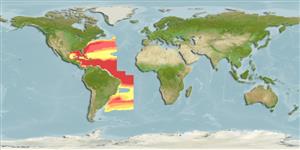Common names from other countries
Teleostei (teleosts) >
Argentiniformes (Marine smelts) >
Argentinidae (Argentines or herring smelts)
Etymology: Glossanodon: Greek, glossa = tongue + Greek, anodos = without teeth (Ref. 45335).
More on author: Cohen.
Issue
Needs a taxonomic reference.
Environment: milieu / climate zone / depth range / distribution range
Ecology
Marine; bathypelagic; depth range 92 - 458 m (Ref. 37473), usually 183 - 366 m (Ref. 37473). Deep-water
Western Atlantic: South Carolina to southern Florida, in the northern Gulf of Mexico, and off Cuba, Nicaragua, Venezuela, and northern Brazil.
Size / Weight / Age
Maturity: Lm ? range ? - ? cm
Max length : 11.3 cm SL male/unsexed; (Ref. 37473)
Inhabits muddy, sand and gravel bottom (Ref. 37473). Sexual maturity reached around 8 cm SL, with female of 7.72 cm SL with ripe eggs and male of 8.66 cm SL with well-developed testes (Ref. 84005).
Life cycle and mating behavior
Maturities | Reproduction | Spawnings | Egg(s) | Fecundities | Larvae
Robins, C.R., R.M. Bailey, C.E. Bond, J.R. Brooker, E.A. Lachner, R.N. Lea and W.B. Scott, 1991. Common and scientific names of fishes from the United States and Canada. Am. Fish. Soc. Spec. Publ. (20):183 p. (Ref. 3814)
IUCN Red List Status (Ref. 130435)
CITES (Ref. 128078)
Not Evaluated
Threat to humans
Harmless
Human uses
Tools
Special reports
Download XML
Internet sources
Estimates based on models
Preferred temperature (Ref.
115969): 10.4 - 20.8, mean 14.9 (based on 111 cells).
Phylogenetic diversity index (Ref.
82804): PD
50 = 0.5001 [Uniqueness, from 0.5 = low to 2.0 = high].
Bayesian length-weight: a=0.00363 (0.00163 - 0.00807), b=3.17 (2.98 - 3.36), in cm Total Length, based on LWR estimates for this (Sub)family-body shape (Ref.
93245).
Trophic level (Ref.
69278): 3.0 ±0.00 se; based on food items.
Resilience (Ref.
120179): High, minimum population doubling time less than 15 months (Preliminary K or Fecundity.).
Fishing Vulnerability (Ref.
59153): Low vulnerability (10 of 100).
